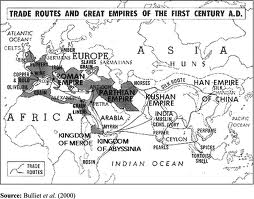Route: Indian Ocean
Advantages: Changeable, predictable monsoon wids lead to reliable schedules; great variety and amound of goods  can be carried via ship (emporium trading); seaborne trade usually faster than land routes
can be carried via ship (emporium trading); seaborne trade usually faster than land routes
Geographical Scope: East Africa, Arabia, Inida, S.E. Asia; canal between Red Sea and Nile would eventually connect Mediterranean
Commerce: Aromatic (incense), spices, gold, and “thousands of other things” (including wild animals)
Political Systems: African kingdoms, Indian empires and kingdoms, Arabian cheifdoms, Mediterranean empires
Route: Silk Roads across Eurasia
Advantages: Less inestment needed to embark on small-scale trading expeditions; more cultural contacts between vast different peoples; widespread trade of high-value items
Geographical Scope: China, Bactria, Sogdiana, Persia, Mesopotamia, Anatolia, Caspian/Black Sea, Mediterranean
Commerce: Spices, silk, gold, silver, cloth, horses, aromatics
Political Systems: Imperial China, Central Asian kingdoms, Egypt, nomadic tribes of Middle East, Perisan Empire, Roman Empire, Mediterranean city-states
Route: Medditerranean
Advantages: Relatively high population densities along the coastal Mediterranean provides more opportunities for trade, numerous ports; shorter distnaces, calmer waters than vat Indian Ocean routes.
Geographical Scope: Europe, North Africa, S.W. Asia, Black Sea, with Red Sea-Nile canal (later in history) connections to Arabia, Indian Ocean Route
Commerce: Grain, wine, olive oil, timber, metals
Political Systems: Greek city-states/colonies, Egypt, North African city-states, Roman Empire
